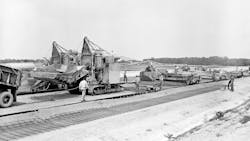From its earliest mechanization in the 1910s into the 1960s, concrete paving involved quite the complicated process. The same work was done as today, but with much different equipment. This image, showing a paving operation on Interstate 95 in Caroline County, Virginia, in August 1963, shows a later example. Let’s look at the equipment involved, left to right.
Although central mix plants had rendered them obsolete, this contractor is using two dry-batch pavers to mix and place the concrete. Aggregates and cement were delivered in pre-measured batches by dump trucks with gated dump boxes and dumped into the pavers’ skips. The skip was raised to charge the mixer, water was added, and a minute later a cubic yard or more of concrete was discharged into the paver’s bucket. The operator directed the bucket to placement as it rolled along a swinging boom that could also be raised, and when it returned another batch of concrete was ready. Two pavers are working here; as many as six have been known to work a single slab. Incidentally, these pavers are products of Foote Manufacturing Co. of Nunda, New York, inventors of the end-discharge dry batch paver.
The pavers are free-traveling, but the rest of the outfit rides on the steel forms. Not shown are the formgrader, which used a stringline to guide a cutting wheel that excavated a slot for the forms to grade, and a form tamper that secured them in place. Also out of view are form-riding trimming and finegrading equipment, except for one being pulled by the pavers.
The concrete is spread and consolidated by, appropriately, a spreader. Details varied, but a spreader typically used an auger to distribute the concrete, and vibrators to condense it and remove voids. A finisher to smooth the surface follows and, starting in the 1950s, spreading and finishing functions were sometimes combined into one machine. During the spreading process, sheets of mesh rebar are manually placed.
Following the finisher is a mechanized float with a screed that moves longitudinally within a large frame to provide final finishing. Additional machines in such a spread could include a jointer, curing applicator, and a rig to drag a sheet of burlap to texture the surface. After all was done, pins were pulled, and the forms had to be removed and reused or stored.
About the Historical Construction Equipment Association
The Historical Construction Equipment Association (HCEA) is a 501(c )3 nonprofit organization dedicated to preserving the history of the construction, dredging and surface mining equipment industries. With over 3,500 members in a dozen countries, our activities include operation of National Construction Equipment Museum and archives in Bowling Green, Ohio; publication of a quarterly magazine, Equipment Echoes, from which this text is adapted from an upcoming article, and hosting an annual working exhibition of restored construction equipment. Individual annual memberships are $45 within the U.S. and Canada, and $65 elsewhere. Our next International Convention and Old Equipment Exposition will be September 18-20, 2025, at our Museum. We seek to develop relationships in the equipment manufacturing industry, and we offer a college scholarship for engineering students. Information is available at www.hcea.net, or by calling 419.352.5616 or e-mailing [email protected]. Scan this QR Code for information on joining.
About the Author
Tom Berry
Tom Berry is archivist for the Historical Construction Equipment Association (HCEA). Information is available at www.hcea. net, or by calling 419.352.5616 or e-mailing [email protected].

